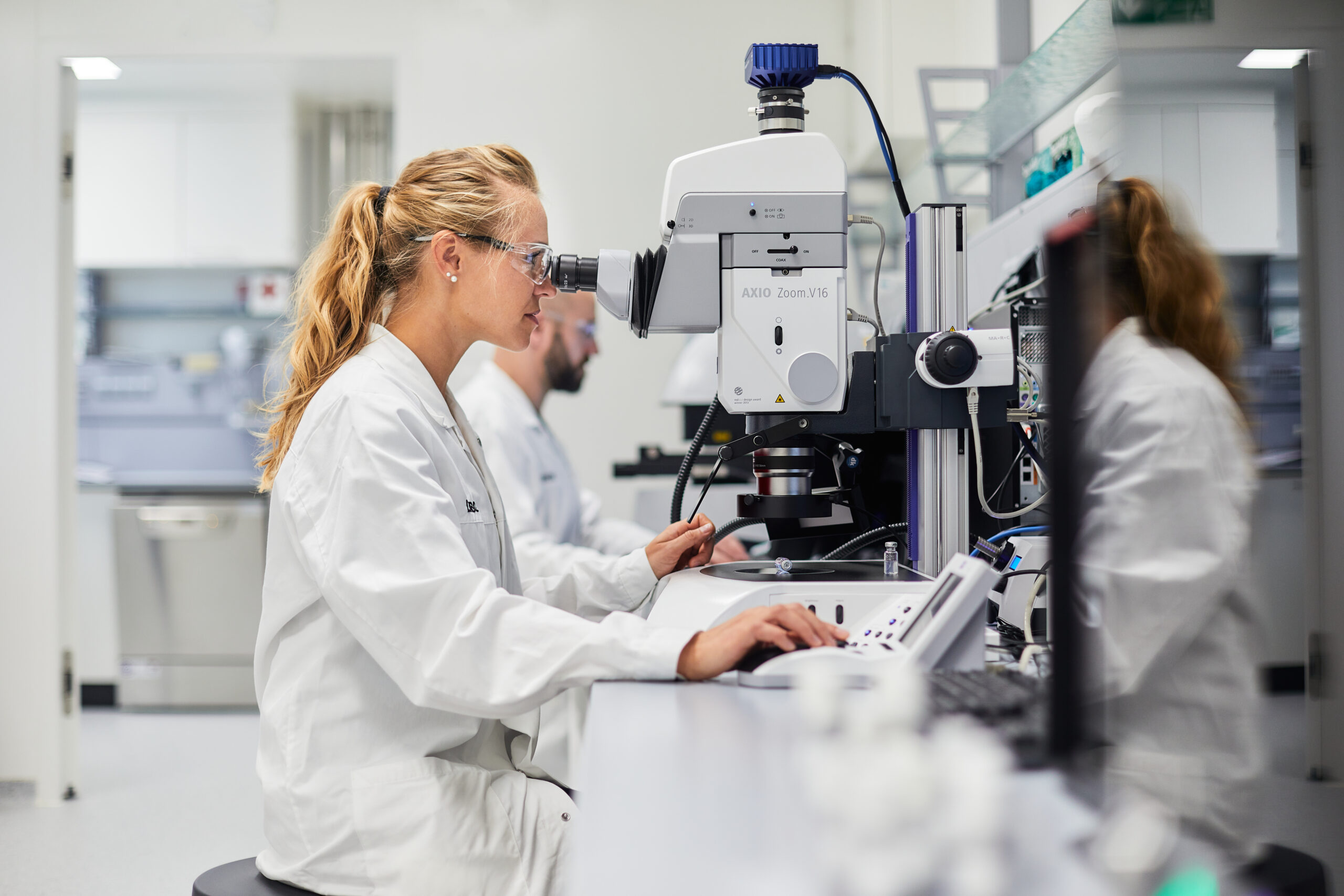WHITE PAPER - Making Sub-Visible Particles Visible: Innovative Analytical Techniques for Detection & Identification

The demand for complex, often life-saving drug substances such as monoclonal antibodies, interferons, and peptides is on the rise, creating a greater need for innovative delivery mechanisms to administer these new therapeutics. For a variety of reasons, sub-visible particles can form in injectable drugs during their manufacturing process or transportation and reduce the drug’s effectiveness. Biologics are particularly prone to sub-visible particle formation. When a drug contains large protein aggregates the patient’s body cells will only be able to partially absorb them or, for some drug products, not at all. Furthermore, particles can trigger unwanted side effects in the patient such as autoimmune responses. Thus, the process of identifying and eliminating sub-visible particles is necessary.
How Sub-Visible Particles Develop
To focus a discussion on sub-visible particles, it is important to understand that there are different types of sub-visible particles and a variety of reasons for how they are generated. Sub-visible particles are in the nanometer to micrometer range and include drug substance aggregates, silicone oil drops, fibers, and other materials. Regardless of their size, particle origination falls into several categories. Extrinsic particles are those which are foreign, additive particles and not part of the drug product formulation or primary packaging material. For example, cellulose fibers from cleaning processes and packaging system materials such as silicone oil or rubber. They can also result due to friction with metal or Teflon. Because these particles arise externally, hence the term ‘extrinsic’, they may not be sterile and could be considered contaminants for the filled unit.
Intrinsic particles are those which are generated directly from the formulation of the drug product or its manufacturing. For example, protein aggregates may be the result of inherent properties of the drug product, interactions of the drug product formulation components, their contact with primary packing materials, or processing aids. Intrinsic particles may also emanate from the drug substance itself. On the other hand, inherent particles are generated from the formulation, for example, when a drug substance or an excipient forms a haze or aggregates, which can result from greater shearing forces, among other causes. Inherent particles do not affect the sterility of the drug; however, they could lower its effectiveness.
New & Innovative Analytical Techniques to Make Sub-Visible Particles Visible
Until now, the current standard technique to determine sub-visible particles in the micrometer range has been light obscuration. This technique, which is a compendial method for routine testing used in a batch release determines the number and size of sub-visible particles in the 1-100 µm range. The method is robust, fast, and reliable. Nevertheless, it does have its limitations especially since a deeper insight into the description of the particle’s morphology and chemical characteristics is not possible. Therefore, the light obscuration technique might best be supplemented with other techniques during the development phase of the drug product.

ASL Analytical Science Laboratory
New analytical technologies have advanced the science of sub-visible particulate matter analysis and can deliver profound knowledge on particle concentration, characterization, and identification. These techniques are used primarily for testing and measuring the limits of the compounding, mixing, and filling procedure design during development. They can also be applied to any issues arising later on in commercial batches by providing additional information to assist in performing a root cause analysis. These methods include:
- Micro-Flow Imaging (MFI) – MFI combines the possibilities of digital microscopy with modern microfluidics, producing high-resolution images of sub-visible particles between 1 μm and 70 μm. Determining the number and size of the particles is then possible, as is particle characterization using modern application software via the morphology of the particles.
- Dynamic & Electrophoretic Light Scattering (DLS, ELS) – DLS is used to determine the particle size and distribution of dispersed particles in the nanometer to low micrometer range. Additionally, the particle mobility and charge could be analyzed by measuring the Zeta potential by applying ELS.
- Digital Microscope Coupled With Raman Spectroscopy – The Morphologi G3-ID offers a unique technology: it combines the automated static imaging functions of a modern, high-resolution microscope with the chemical identification of individual particles using Raman spectroscopy. This process is suitable for the classification of sub-visible particles (1 μm – 1000 μm) according to a very wide range by size and morphology, as well as to identify them chemically by means of Raman spectroscopy.
- Lab-Scale Digital Visual Inspections – The ETAC Proview is a computer-based automated inspection system for use in research and development. It enables objective manual visual inspection by taking and saving high-resolution photos and videos of the filled units from different perspectives using two cameras and a wide range of lighting options. With the help of innovative application software, the precise evaluation of visible mobile and immobile particles or other defects in each unit can be achieved and documented.
Root Cause Analysis for Fast Results
As the number and types of biological drugs continue to grow regulatory authorities will continue to focus on particle contaminants, especially those of sub-visible particulate matter. To be successful, manufacturers must adjust their analytical techniques as well as production processes to rapidly detect sub-visible particles while identifying and reducing the root causes of particle generation. The analysis and characterization of sub-visible particles are a priority during the development phase. New state-of-the-art technologies combined with the latest methods of analysis and experienced scientists have enabled pharma and biotech companies to gain insights into sub-visible particle generation and characterization. Manufacturers of parenteral drugs will benefit from the knowledge of the processes involved and will be able to expand on their high-quality standards.
Vetter’s Center of Excellence Particulate Matter
At Vetter, a global leading Contract Development and Manufacturing Organization (CDMO) specializing in aseptic fill and finish for injectables, it is essential to reliably evaluate and understand the data and draw the right conclusions for its internal processes. This requires a great deal of expert knowledge. As such, a Center of Excellence Particulate Matter was established as part of the Development Service department. The Center is comprised of a team of scientists with extensive analytical knowledge as well as a deep understanding of the internal processes. The team, which operates in a highly networked manner, has particular expertise regarding respective particles and how they are created. With the Center of Excellence Particulate Matter in-house, the reliance on external laboratories and the organized effort of sample shipment is rendered unnecessary. This approach ensures that the results are classified in a well-founded manner and that the work is carried out efficiently. The expertise gained from various analyses and the networking of the Center’s internal teams helps ensure continuous learning and further development. As the specialist’s knowledge of the manufacturing and the particle formation processes increases, they can continuously optimize the analytical services and offer a wide range of support to help meet the challenges inherent to the topic of particulate matter and deliver safe products to customers.
 About the Author
About the Author
Dr. Melanie Zerulla-Wernitz is the Head of the Analytical Science Laboratory and therefore responsible for a diverse team of excellent scientists combining various natural and applied sciences. She holds a PhD in natural science from the University of Konstanz, Germany. After many years in preclinical development Dr. Zerulla-Wernitz joined Vetter Pharma in 2004. Her career started in the quality control department but lead her after a little while into the upcoming Development Service. With a one year excursion to Vetter’s Development Service in Chicago, she is continuously leading the Analytical Science Laboratory and constantly working on the enlargement of its service and analytical portfolio.
![]()
About Vetter
Headquartered in Ravensburg, Germany, Vetter is a family-owned, global leading contract development and manufacturing organization (CDMO) with production facilities in Germany, Austria, and the US. Currently employing more than 5,700 individuals worldwide, the company has long-term experience in supporting biotechnology and pharmaceutical customers both large and small. Vetter services range from early stage development support including clinical manufacturing, to commercial supply and numerous packaging solutions for vials, syringes and cartridges. As a leading solution provider, Vetter appreciates its responsibility to support the needs of its customers by developing devices that contribute to increased patient safety, convenience, and enhanced compliance. Great importance is also given to social responsibility, including environmental protection and sustainability. Learn more about Vetter at www.vetter-pharma.com.
Total Page Views: 3228









